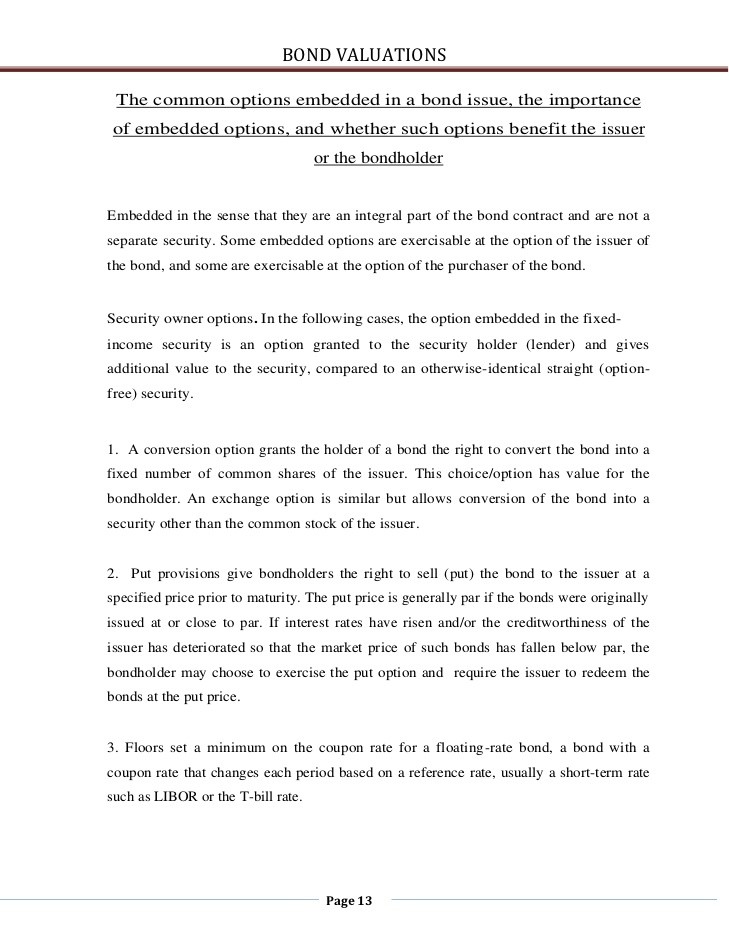Options Embedded in Bonds
Post on: 21 Май, 2015 No Comment

Options Embedded in Bonds
July 30th, 2010
We have so far looked at two forms of duration: Macaulay and modified. There are a couple of more that deserve attention. But first we need to explain the concept of an embedded option.
Embedded options are “kickers” that provide a bond issuer or bondholder with the possibility of taking some action (with respect to another party) that is not available in “straight vanilla” bonds. There are four common types:
Callable – allows the bond issuer to force the redemption of bonds before maturation. The issuer has a date-limited (the call date ) opportunity, but not an obligation, to redeem the bond at a predetermined price (the call price ). This embedded call lowers the value of the bond to the bondholder, because of the possibility of a truncated set of cash flows. Therefore the issuer must normally issue the bonds with an elevated interest rate (equivalently, a lower price) to compensate the buyer for call risk.
The embedded call option can be valuable to an issuer if interest rates decline between the issue date and the call date – the issuer can call the bonds and issue new ones at a lower coupon. The call price is usually above the issue price; the differential is called the call premium. Nonetheless, if interest rates decline enough, the call price will be less than the bond’s current market price, and is thus a bargain for the issuer at the expense of the holder.
The price of a callable bond is equal to the value of the straight bond plus the value of the option. This causes the yield on a callable bond to exceed that of the corresponding straight bond. Bonds can be issued with a multi-date call schedule. where portions of the issue can be redeemed at any of several different call dates.
Puttable – allows the bondholder to demand early repayment on one or more specified put dates. It is the equivalent of a straight bond and a put option, and confers additional value to the bond holder. Issuers can sell puttable bonds at a premium relative to the equivalent straight bond because of the put’s additional value to the bondholder. Bondholders are likely to put the bond to the issuer if interest rates have risen since the issue date, because the equivalent straight bond’s market price will have declined under this circumstance.
Purchasers of puttable bonds will see their put’s value decrease if the issuer is bankrupt on the put date. Bankruptcy will not necessarily render the embedded put’s value worthless, as it confers a higher claim by the puttable bond on assets relative to straight bonds.
A bond may be both puttable and callable; the issue price of the bond is influenced by both options.
Convertible – a bond that can convert into a predetermined number (expressed by the conversion ratio ) of an issuer’s shares at a predetermined conversion price. The price of this hybrid security is thus correlated, within limits, to the price movement of the underlying shares. It is equivalent to holding a straight bond plus a call option on the underlying stock, except that executing the call option requires surrender of the convertible bonds. A large price decline of the underlying stock creates a “broken convert ”; the floor on the convertible bond’s price is the price of the equivalent straight bond, the call premium having disappeared. Thus the bondholder has upside potential with limited downside risk. This mixture benefits the bondholder and thus allows bond issuers to sell convertible bonds at a premium to the equivalent straight bond. This is the same as saying that the issuer can provide a lower coupon rate. Convertible bonds are dilutive – they have the potential to increase the number of issued shares and thus may reduce equity per share.
We’ll have a lot more to say about convertible bonds in a future article.
Exchangeable – similar to a convertible bond, except the underlying shares are for a company other than the issuer.
Armed with this information, we can next time resume our review of the different varieties of bond duration.














